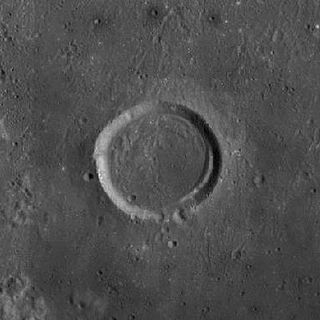
Hohmann is a lunar impact crater that lies within the central basin of the Mare Orientale formation, on the farside of the Moon. It is located to the south of the crater Maunder, and to the west of Kopff crater. Due to its proximity to the western lunar limb, this area of the surface is occasionally visible during favorable librations. However the basin is viewed from the side, restricting the amount of detail that can be observed from Earth.

Atwood is a small lunar impact crater that is located on the Mare Fecunditatis, to the northwest of the prominent crater Langrenus. It forms a triple-crater formation with Naonobu attached to the north rim and Bilharz near the west rim.

Blackett is a lunar impact crater that lies on the far side of the Moon, behind the southwest limb. It lies beyond the southeast outer ring of the immense Mare Orientale basin. The formation of that major feature has left Blackett deeply marked with ridge features trending from the northwest. Much of the crater has been shaped by the ejecta from Mare Orientale, particularly along the western half of the crater.

Darwin is a lunar impact crater of the type categorised as a walled plain. It lies in the southeastern part of the Moon, and is sufficiently close to the limb to appear significantly foreshortened when viewed from the Earth. Attached to its southern rim is Lamarck. To the northeast is the dark-floored crater Crüger.
Lagrange is a lunar impact crater that is attached to the northwestern rim of the crater Piazzi. It lies near the southwestern limb of the Moon, and the appearance is oblong due to foreshortening. To the northwest of this feature is the Montes Cordillera, a ring-shaped mountain range that surrounds the immense Mare Orientale impact basin.
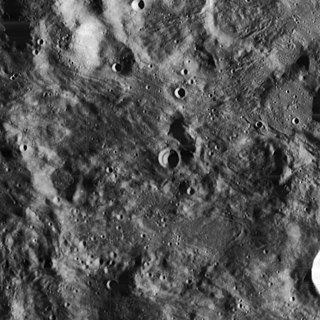
Lamarck is a crater in the southwestern part of the Moon. The northern portion of the crater is overlain by the walled plain Darwin. To the southeast is Byrgius.
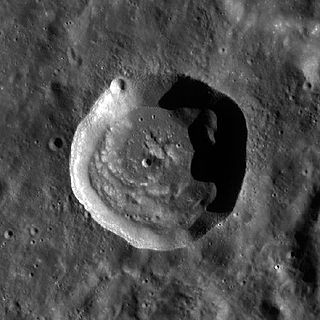
Chant is a lunar impact crater that is located on the far side of the Moon, behind the southwest limb as seen from the Earth. It lies within the southwestern part of the blanket of ejecta surrounding the Mare Orientale, beyond the Montes Cordillera mountain ring. To the west-northwest is the large walled plain Blackett. Southward is the crater Mendel.

Chadwick is a lunar impact crater that lies on the far side of the Moon's surface, just beyond the southwestern limb. It is located to the northwest of the crater De Roy, and was previously designated De Roy X before being given its current name by the IAU. This region of the lunar surface lies at the southern end of the ejecta blanket that surrounds the Mare Orientale impact basin.

Hartwig is a lunar impact crater that is located near the western limb of the Moon. It is attached to the eastern rim of the prominent crater Schlüter, to the northeast of the Montes Cordillera mountain range that surrounds the Mare Orientale. To the east-northeast of Hartwig is the larger crater Riccioli.
Piazzi is an impact crater that is located near the southwestern limb of the Moon, and is attached to the southeastern rim of the walled plain Lagrange. About three crater diameters to the south is the crater Inghirami. Piazzi is seen at an oblique angle from the Earth, and it appears oblong due to foreshortening.

Chalonge is a lunar impact crater that is located on the far side of the Moon. It lies to the southwest of the larger crater Lewis, in the outer skirt of ejecta that surrounds the Mare Orientale impact basin. To the southeast are the Montes Cordillera, a ring of mountains that encircle the Mare Orientale formation.

Ellerman is a lunar impact crater on the far side of the Moon. It lies within the outer blanket of ejecta that surrounds the Mare Orientale impact basin, and is located to the west of the Montes Cordillera mountain range. To the northwest of Ellerman is the larger crater Gerasimovich.

Elvey is a lunar impact crater that is located on the far side of the Moon. It is located near the northern edge of the blanket of ejecta that surrounds the Mare Orientale impact basin. To the north of Elvey is the smaller crater Nobel.

Fridman is the remains of a lunar impact crater on the far side of the Moon. It lies due south of the huge walled plain Hertzsprung, and is attached to the northeastern rim of the crater Ioffe.

Gerasimovich is a lunar impact crater on the far side of the Moon. It lies beyond the western limb, to the west-northwest of the immense Mare Orientale impact basin. The outer blanket of ejecta from this impact reaches nearly to the rim of Gerasimovich. Nearby craters of note include Houzeau to the north and the smaller Ellerman to the southeast.
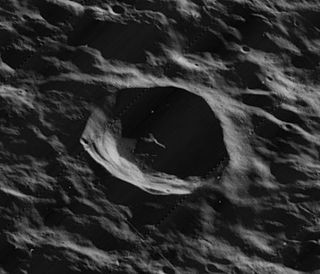
Grachev is a lunar impact crater on the far side of the Moon. It lies to the northwest of the Mare Orientale impact basin, in the outer skirt of ejecta surrounding the Montes Cordillera mountain ring. Passing along the southwestern edge of Grachev is the Catena Michelson, a valley-like formation composed of a linear chain of small craters. This feature is radial to the Mare Orientale basin. To the north is the crater Leuschner.
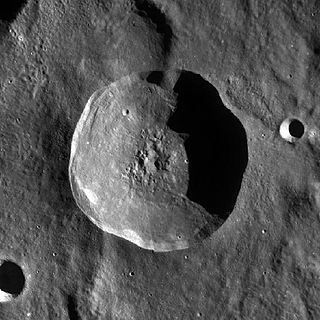
Guthnick is a lunar impact crater that lies on the far side of the Moon's surface from the Earth. However, it is located in the part of the far side that is sometimes brought into sight of the Earth due to libration, although it can only be seen at a low angle and during favorable lighting conditions. Guthnick is situated in the southern portion of the huge skirt of ejecta that surrounds the Mare Orientale impact basin. Less than a crater diameter to the northwest is the slightly larger crater Rydberg. To the south-southwest is the small Andersson.

Kearons is a small lunar impact crater that is located on the far side of the Moon, to the northwest of the Mare Orientale impact basin, in the outer skirt of ejecta that surrounds the Montes Cordillera range. It is a relatively isolated crater, possibly because any nearby features have been buried under the ejecta. Some distance to the south is the crater Lewis, and to the north-northeast lies Grachev.

Stetson is the remains of a crater on the far side of the Moon. The northeastern part of the rim of Stetson has been overlain by the larger crater Blackett. Lying across the eastern rim is a double-crater formation consisting of the satellites Stetson E and Stetson G. There are also small craters along the southeast and northwestern rims.
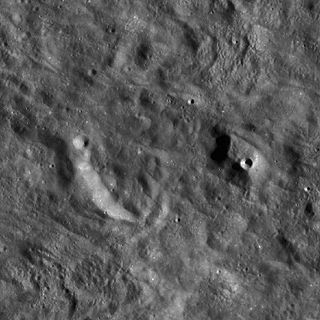
Lewis is a crater on the far side of the Moon. It lies along the western edge of the Montes Cordillera mountains that surround the Mare Orientale impact basin. This crater has been heavily disrupted by the formation of the basin, and it is covered by ejecta from the impact leaving only an uneven depression in the surface. The outer rim is roughly circular, and the interior is uneven.


























